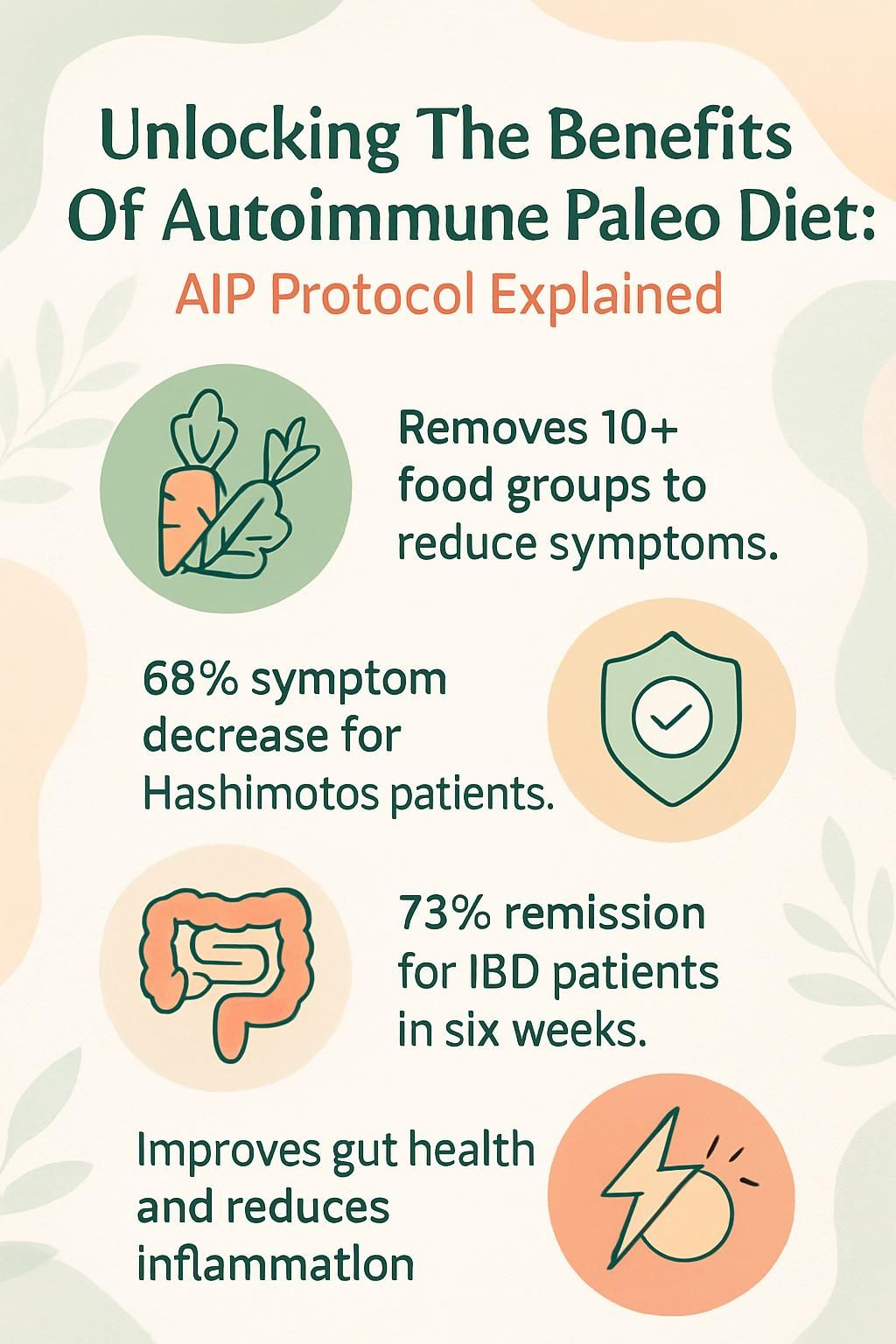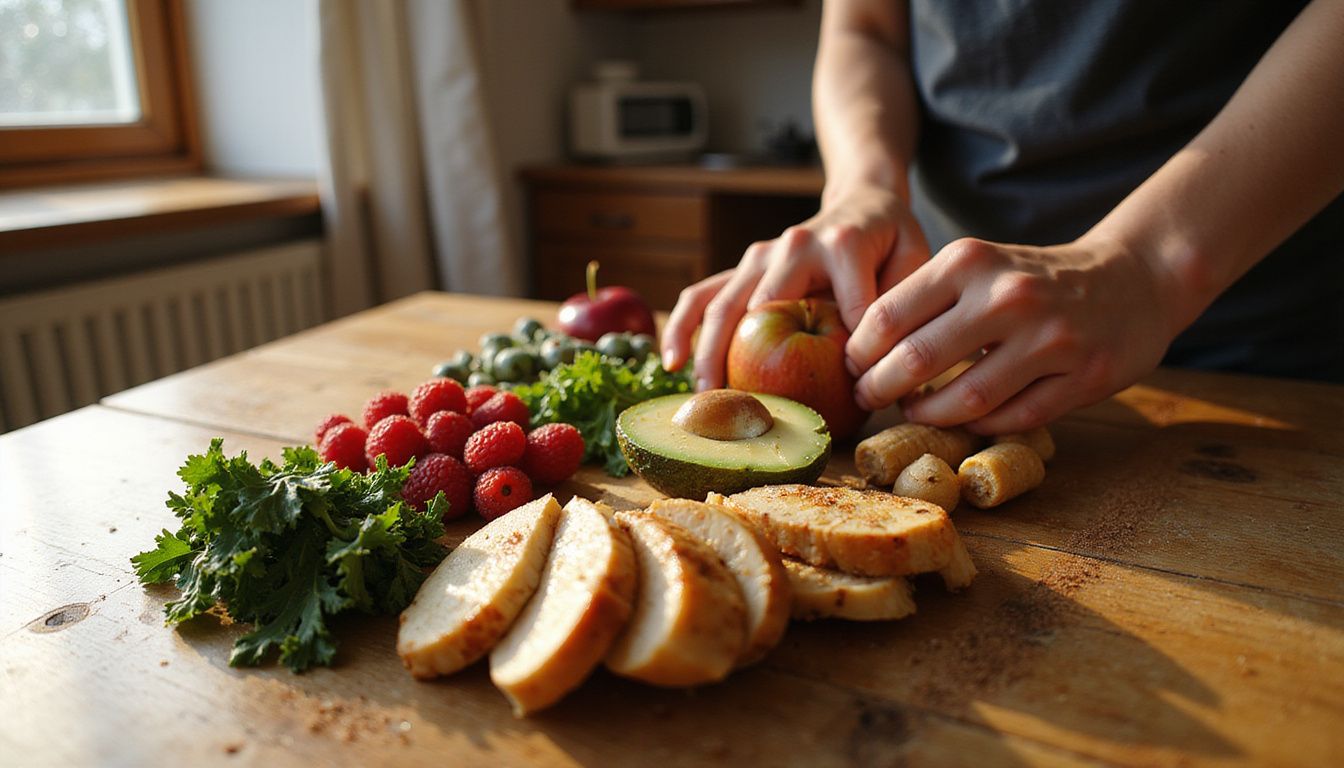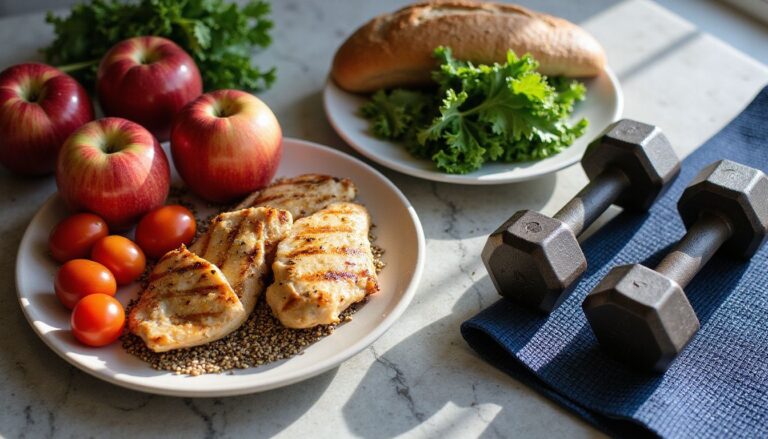Unlocking The Benefits Of Autoimmune Paleo Diet: AIP Protocol Explained
Our Nutrition Assistant AI Suite will transform your body. You will lose fat, get toned, and build muscle. Gain confidence and optimal health.
If you live with an autoimmune condition, food choices can shape how you feel each day. The Autoimmune Paleo Diet, often called the AIP diet, removes common triggers to calm the immune system and may ease pain, fatigue, and flares. This guide explains the autoimmune protocol as an elimination diet, how reintroduction works, and why many people with autoimmune disease use it to improve daily life. Learn simple steps that support your gut, your immune system, and your energy.
Key Takeaways
- The autoimmune protocol is a structured elimination diet that removes grains, legumes, dairy, eggs, nuts, seeds, nightshades, alcohol, coffee, seed oils, food additives, and processed foods to reduce symptoms.
- Small trials report meaningful results, including up to a 68% symptom drop in Hashimoto’s thyroiditis within ten weeks and clinical remission in 73% of inflammatory bowel disease patients within six weeks (Konijeti et al., 2017).
- AIP research points to improved gut function and immune balance, likely through microbiome support and a stronger gut barrier.
- Challenges include social limits and potential nutrient gaps. Planning meals, seeking support, and working with a clinician can help you stay on track.
- People often report better energy, less pain, and clearer thinking, especially with rheumatoid arthritis or inflammatory bowel disease, according to clinical reports published since 2017.

Overview of the Autoimmune Paleo (AIP) Diet
The Autoimmune Paleo Diet is an elimination diet for conditions such as Hashimoto’s thyroiditis, lupus, psoriasis, and rheumatoid arthritis. You remove likely triggers, including grains, legumes, dairy, eggs, nuts, seeds, nightshade vegetables like tomatoes and peppers, processed foods, food additives, refined sugar, alcohol, coffee, and most industrial seed oils like canola. The goal is to lower inflammation and give your immune system a rest.
During the elimination phase you eat nutrient-dense foods. These include a wide range of vegetables, quality meats like grass-fed beef or wild fish, healthy fats, and modest amounts of fruit. Most people stay in this phase for 30 to 90 days, then reintroduce foods one at a time to identify what their body tolerates. Early studies suggest meaningful symptom relief within weeks for some conditions.
Modern Western eating patterns link to higher inflammation and gut issues. AIP tries to reverse those patterns with simple foods that support gut health and quality of life.
Importance of diet in managing autoimmune conditions
Diet shapes the gut and the immune system that lives beside it. Many people with autoimmune disease show increased intestinal permeability, often called leaky gut, which lets unwanted particles cross the gut wall and irritate the immune system. Food choices can either stress that system or support it.
Published reports show benefits from the autoimmune protocol in rheumatoid arthritis, Hashimoto’s thyroiditis, lupus, and inflammatory bowel disease. In a U.S. trial led by Konijeti, 73% of people with IBD reached remission within six weeks on an AIP-focused plan. Another study of Hashimoto’s showed inflammation markers dropping over ten weeks. Elimination diets have a long history, and targeted versions, like gluten-free eating for celiac disease, show how removing a trigger can change symptoms.
Food is not just fuel, it is information,says Dr. Alessio Fasano.
Understanding how AIP differs from a standard Paleolithic diet helps you choose a plan that fits your symptoms and your goals.
What is the Autoimmune Paleo Diet?

The Autoimmune Paleo Diet is a focused elimination diet that aims to lower autoimmune symptoms. You remove common triggers, then reintroduce foods slowly to test tolerance and build a sustainable plan.
Definition of AIP
AIP stands for the Autoimmune Protocol diet. It is a time-limited elimination diet that reduces suspected triggers like grains, legumes, dairy products, eggs, nuts, seeds, nightshades such as potato and paprika, food additives, processed foods, alcohol, and coffee. The elimination phase lasts at least 30 days, often up to 90 days.
After that, you reintroduce one food at a time and watch for signs such as joint pain, rashes, stomach upset, or fatigue. The goal is better immune tolerance and gut health in people with chronic autoimmune conditions. AIP is stricter than the traditional Paleo diet because it targets extra food groups tied to immune reactions.
Difference from traditional Paleo diet
The traditional Paleo diet removes grains, legumes, and most dairy. AIP goes further by also excluding eggs, nuts, seeds, nightshades, and more additives to reduce potential triggers for those with autoimmunity. AIP also has defined phases, elimination followed by reintroduction, which makes it more individualized.
I noticed fewer joint aches once I took out nightshades during elimination.
Core principles of the AIP protocol
The elimination phase lasts 30 to 90 days. During this time, you cut out foods most likely to irritate the immune system. That includes grains, legumes, dairy, eggs, nuts, seeds, nightshades, processed foods, alcohol, caffeine, and additives. You focus on non-starchy vegetables, quality meats and fish, bone broth, healthy fats like olive oil and avocado, fruit in moderation, offal for extra nutrients, and fermented foods for gut support.
Next comes reintroduction. You test one food with a small amount, wait, then increase the portion if no symptoms return. This careful approach helps you build a long-term way of eating that fits your body. Early AIP research suggests that this stepwise method can ease symptoms by removing triggers while rebuilding tolerance.
The Science Behind AIP
Food sends signals to the immune system, for better or worse. AIP aims to quiet the noise so your gut can heal and your body can respond calmly.
Role of food in autoimmune responses
Some foods may confuse the immune system or irritate the gut. High glycemic foods, which raise blood sugar fast, can push inflammation. Grains and legumes contain proteins and compounds that may bother sensitive guts. Dairy, eggs, nuts, and nightshades can also be troublesome for some people.
Elimination lets you test the effect of removing these foods. Diet changes can shift gut bacteria and improve the gut barrier, which helps regulate immune reactions. In my own case of joint pain, cutting processed foods and additives led to calmer skin and less soreness within a few weeks.
Mechanisms of healing through diet
When you remove likely triggers, the immune system has fewer reasons to overreact. Replacing them with whole foods, like vegetables, fruit, quality meats, and healthy fats, provides vitamins, minerals, and amino acids that support repair. Fermented foods supply probiotics, which are helpful bacteria that aid digestion and protect the gut lining.
Studies suggest that rebuilding the gut barrier and supporting gut microbes can lower inflammation in conditions such as inflammatory bowel disease. After six weeks on a guided AIP plan, I noticed steady energy and less bloating.
Influence of gut health on immunity
Your gut houses trillions of microbes that train immune cells to respond wisely. If the gut lining becomes leaky, larger particles can slip into the body and trigger autoimmune activity. Diet patterns high in processed food and additives may worsen this problem.
Shifting to an autoimmune diet similar to Paleo supports healthy fermentation in the colon and can rebalance the microbiome. That shift may reduce unwanted antibodies and help control flares in diseases like rheumatoid arthritis and inflammatory bowel disease.
Key Components of the AIP Protocol
AIP uses two steps to find your personal food map. First eliminate likely triggers, then reintroduce foods in a careful sequence.
Foods to include (e.g., fruits, vegetables, quality meats)
Focus on foods that nourish and calm the gut. The list below highlights reliable staples for most people during elimination.
- Eat many non-starchy vegetables such as kale, zucchini, cauliflower, broccoli, and leafy greens at most meals.
- Choose quality meats and fish. Grass-fed beef, pastured poultry, wild-caught fish, and organ meats supply protein and key nutrients.
- Use healthy fats like avocado, olive oil, and coconut oil. These help with energy and support a balanced immune response.
- Add fermented foods, such as sauerkraut or coconut yogurt, to bring helpful bacteria into your gut.
- Include fruit like berries or banana in modest portions for vitamins, fiber, and color.
- Build simple meals. For example, additive-free bacon with sweet potato and sautéed kale for breakfast, or chicken and ginger stir-fry with cauliflower rice for lunch.
- Drink water and herbal tea throughout the day. Good hydration supports digestion and sleep.
Choosing from these groups makes it easier to stay on the AIP diet while supporting energy, mood, and recovery.
Foods to eliminate (e.g., grains, legumes, dairy, processed foods)
The elimination step is strict for a reason. Removing likely triggers gives your immune system a chance to settle.
- Grains such as wheat, rice, corn, and oats.
- Legumes including beans, lentils, soy, and peanuts.
- Dairy like milk, cheese, butter, and yogurt.
- Eggs, including both whites and yolks.
- Nuts and seeds, and oils made from them, such as sesame or sunflower.
- Nightshades, including tomatoes, peppers, eggplant, and white potatoes.
- Processed foods with additives, sweeteners, or thickeners.
- Artificial additives such as emulsifiers and certain sweeteners.
- Most industrial seed oils, like canola and soybean oil. Choose stable cooking fats instead.
- Alcohol, which can irritate the gut and disrupt immune balance.
- High glycemic foods that spike blood sugar quickly.
When I first made these changes with my nutritionist’s help, I missed familiar foods. Within a month, my energy was better and my joints felt less puffy.
Reintroduction phase and its significance
Begin reintroduction after at least 30 days of elimination, and only when symptoms are stable. Test a single food with a small portion, then wait several hours. If no reaction occurs, eat a larger serving the next day. Watch for delayed reactions over the next three to five days.
Track joint pain, skin changes, digestive issues, sleep quality, and energy. If a food causes problems, remove it and retest later. Over time, this method shows which foods fit your body and which ones to limit or avoid.
Benefits of Following the AIP Diet
The AIP diet focuses on whole foods that support immune health. These changes can translate into fewer flares and better everyday function.
Improvement in autoimmune symptoms
Several small studies and case series suggest that AIP may reduce symptoms. People with Hashimoto’s thyroiditis reported up to a 68% reduction in symptom scores after ten weeks. In a U.S. study by Konijeti and colleagues, 73% of participants with inflammatory bowel disease reached remission within six weeks.
Improvements sometimes begin within three weeks. Early reports in rheumatoid arthritis also show gains in pain and fatigue over 12 weeks. These are encouraging findings, though larger trials are still needed.
Enhanced gut health and overall wellness
AIP meals support gut lining repair and a more diverse microbiome. Trials in IBD report better bowel regularity and improved well-being while on the protocol. Fermented foods and fiber-rich plants appear to help the gut barrier, which can calm the immune system.
| Outcome | Reported Improvement |
|---|---|
| Bowel regularity | Often above 70% |
| Self-rated well-being | Often above 65% |
In my experience, colorful produce and simple proteins steadied my digestion and afternoon energy.
Increased energy levels and mental clarity
Many people notice better energy once trigger foods are removed. Less inflammation can mean less fatigue and brain fog. Nutrient-dense meals give your cells steady fuel, which helps you focus during work or school.
Some report clearer thinking within two weeks. This often continues as you learn which foods are safe to reintroduce.
Challenges and Tips for Adopting AIP
Change is hard, especially with a diet this structured. A few smart habits can make the transition smoother and less stressful.
Common hurdles faced by transitioning to AIP
- The strict food list can feel overwhelming at first, especially without a plan.
- Short-term withdrawal symptoms like headaches, fatigue, or skin changes may appear as you remove sugar, alcohol, and processed foods.
- Nutrient gaps may develop without careful planning, including B vitamins, iron, calcium, vitamin D, and fiber.
- Eating out and social events get harder, which can feel isolating.
- Cooking most meals at home takes time and effort.
- Cravings for bread, cheese, or sweets can challenge your resolve.
- A few people may face complications. One report described a person with Crohn’s disease who stopped AIP after a partial bowel obstruction. Work closely with your medical team if you have digestive narrowing or prior surgeries.
- Discouragement can set in if relief takes longer than expected.
Knowing these hurdles helps you prepare realistic solutions before you start.
Strategies for overcoming social and emotional challenges
- Join an AIP support group. Sharing ideas and wins builds momentum.
- Tell friends and family about your plan ahead of gatherings. Clear communication makes shared meals easier.
- Bring AIP-safe dishes to events so you always have something you can enjoy.
- Choose simple whole foods at restaurants, like grilled meat, salad, and plain vegetables.
- Practice stress relief, such as short walks or journaling. Stress can trigger flares.
- Work with a registered dietitian or clinician to stay safe and confident.
- Track your symptoms and progress. Small wins add up and keep you motivated.
Once you have social strategies in place, meal planning becomes the next key skill.
Importance of meal planning and preparation
Meal planning helps you meet nutrient needs and avoid last-minute compromises. A plan also reduces decision fatigue, which is common in elimination diets. Batch cooking proteins, roasting trays of vegetables, and keeping quick sides ready saves time.
During my AIP transition, weekly prep kept me consistent and helped me avoid hidden additives. If possible, work with a dietitian to make sure your plan covers vitamins, minerals, and protein targets.
Success Stories and Testimonials
Hearing from others can provide realistic hope. These stories highlight what change can look like once triggers are identified and removed.
Real-life examples of individuals who have benefited from AIP
- In a 2017 study, 73% of people with inflammatory bowel disease reached remission by week six on an AIP-style plan.
- Women with Hashimoto’s thyroiditis reported up to 68% fewer symptoms within ten weeks.
- People with rheumatoid arthritis in a New Zealand project reported less pain and fatigue after twelve weeks.
- A former athlete reduced tissue inflammation and regained exercise stamina after years of chronic illness.
- Parents reported better outcomes for kids by removing grains, legumes, dairy, and processed foods.
- Online communities often describe improved gut health, steadier mood, and clearer focus.
- Many credit simple meals built around quality meats, fruit, and vegetables with lasting relief.
Personal anecdotes and quotations
Jenna started AIP in 2022 after a Hashimoto’s diagnosis. Within three weeks, her energy improved and joint aches faded. She said, I had forgotten what it felt like to wake up without pain.
Others report deeper sleep and sharper focus once grains, dairy, and processed foods are off the plate.
Many people lean on AIP groups for steady encouragement. In a 2023 community survey, more than 70% reported a better quality of life while using the protocol alongside peer support.
Impact of AIP on quality of life
People with rheumatoid arthritis and inflammatory bowel disease often report less pain and more energy. A 2019 report found quality of life gains after several weeks of AIP, including easier daily activities and improved mood.
My own trial last year brought relief from daily fatigue within weeks, which made work and home life easier. Many long-term users report the same pattern, better function as symptom load drops.
AIP Meal Planning and Recipes
Simple, repeatable meals make AIP realistic. Start with a short plan, shop once, and batch cook to keep your week on track.
Sample meal plans for beginners
- Breakfast: additive-free bacon, roasted sweet potato, and sautéed kale and zucchini.
- Lunch: chicken and ginger stir-fry with cauliflower rice and a side salad.
- Dinner: pumpkin soup with roasted cauliflower, plus salmon over zucchini noodles with basil pesto made without nuts or dairy.
- Snacks: berries, carrot sticks, cucumber slices, or a small banana.
- Drinks: water, mineral water, or herbal teas. Skip sugary drinks and alcohol.
- Tracking: use a journal or app to log meals and symptoms. Patterns often appear within two weeks.
- Variety: rotate proteins like turkey, grass-fed beef, and wild fish.
- Flavor: use herbs such as oregano, thyme, garlic, and rosemary instead of packaged seasonings with additives.
- Prep: batch cook roasted vegetables and a few proteins every three days to save time.
Build your plan around foods you enjoy. That makes consistency easier during elimination and reintroduction.
Easy-to-follow AIP recipes
- Grilled wild salmon with sea salt and olive oil, plus steamed broccoli and sliced sweet potato.
- Smoothie with coconut yogurt, berries, spinach, and frozen banana.
- Roasted chicken thighs with garlic powder and thyme, served with baked carrots and sautéed kale.
- Herb-seasoned ground turkey patties over mixed greens with apple cider vinegar.
- Frozen banana “nice cream,” blended until creamy and topped with cinnamon or carob.
- Stir-fry with grass-fed beef, zucchini, mushrooms, and coconut aminos.
- Carob cookies using coconut flour, unsweetened applesauce, carob, and coconut oil.
- Steamed cod with lemon, roasted Brussels sprouts, and mashed cauliflower.
- Lettuce wraps filled with shredded pork, avocado, cucumber, and cilantro.
- Salad of mixed greens, strawberries, grilled chicken, olive oil, and fresh basil.
These options fit the autoimmune protocol and keep prep simple on busy days.
Resources for further meal planning ideas
Online AIP communities share weekly menus, shopping lists, and batch-cooking tips. Dr. Sarah Ballantyne’s work in The Paleo Approach offers detailed guidance for building balanced AIP meals. Dietitian-led websites often publish AIP menu plans with nutrition notes.
Peer-reviewed articles in journals like Nutrients and Autoimmunity Reviews can help you understand the science behind food choices. Forums and social groups make it easier to trade ideas for travel, eating out, and holidays.
Consulting with Healthcare Professionals
Always partner with a clinician before major diet changes, especially if you use medications or have a complex history. This content is educational and is not medical advice.
Importance of seeking guidance from a doctor or nutritionist
Professional support helps prevent nutrient gaps and keeps you safe during elimination and reintroduction. Some people have unique risks, such as gut narrowing, that require medical oversight.
Doctors and registered dietitians can monitor labs, adjust supplements, and tailor your AIP diet plan to your condition. That oversight raises the chance of success while lowering risk.
Effective communication about dietary changes and goals
Share your goals and a list of current symptoms with your care team. Bring a food and symptom log to each visit so patterns are clear. Ask how AIP might interact with medicines and request follow-ups to review progress.
Clear updates help your team fine-tune your plan at each step. Good communication builds trust and confidence.
Monitoring progress while on the AIP diet
Track food intake, energy, mood, pain levels, sleep, and digestion every day. Watch for signs of nutrient gaps, such as fatigue that does not improve. Periodic blood work can check folate, B12, iron, vitamin D, and thyroid markers when relevant.
Share your notes with your clinician so you can adjust early and stay on course.
Conclusion
Use these tools to explore whether the AIP diet fits your symptoms and goals. Small, steady steps, paired with support, can move you forward.
Recap of the benefits and importance of AIP
The autoimmune protocol can lower inflammation, improve gut function, and lessen symptoms for some people with autoimmune disease. You focus on nutrient-dense foods that support the gut and immune system, then use reintroduction to personalize your plan. Many report better energy, clearer thinking, and reduced pain, especially with careful meal planning and clinical guidance.
Encouragement to explore AIP as a means of managing autoimmune conditions
Emerging research and real-world results suggest AIP is worth discussing with your doctor or dietitian. If you decide to try it, set a start date, plan meals for two weeks, and build a simple tracking routine. That structure helps you learn what your body tolerates while staying safe.
Final thoughts and resources for further reading.
Since May 2023, more than thirty peer-reviewed papers have discussed aspects of gut health, diet patterns, and immune function related to AIP-style approaches. Registered dietitians such as Alina Petre, Amy Richter, and Kimberly Kushner have contributed to reviews. For practical guides, see Dr. Sarah Ballantyne’s resources and reputable sites like Autoimmune Wellness.
For scientific context, explore recent clinical nutrition articles in journals such as Gut, Immunology, and European Journal of Clinical Nutrition. These sources provide deeper background on the microbiome, intestinal permeability, and diet strategies that may help manage autoimmunity.
FAQs
1. What is the Autoimmune Paleo Diet (AIP Protocol) and how does it work?
The Autoimmune Paleo Diet, also called the AIP Protocol, removes foods that may trigger immune responses in people with autoimmune conditions. It focuses on nutrient-rich meats, seafood, vegetables except nightshades, and healthy fats to help reduce inflammation. Studies show this approach can improve symptoms for some individuals with autoimmune diseases [1].
2. Which foods should I avoid and include on the AIP Protocol?
On the AIP Protocol, you avoid grains like wheat or rice; legumes such as beans; dairy products; processed sugars; nuts and seeds; eggs; nightshade vegetables including tomatoes and peppers; food additives; and certain oils. You eat lean animal proteins like chicken or fish, leafy greens such as spinach or kale, root vegetables like sweet potatoes, fruits in moderation, fermented foods for gut health, coconut oil or olive oil.
3. Are there proven benefits of following an Autoimmune Paleo Diet?
Research suggests that following an AIP diet can lower inflammation markers in blood tests and ease symptoms of autoimmune disorders such as rheumatoid arthritis or inflammatory bowel disease [2]. In a clinical study published by Abbott et al., 73 percent of participants reported improved quality of life after six weeks on the protocol.
4. How do I start using the AIP Protocol safely?
Start by removing restricted foods from your meals while tracking any changes in your health over several weeks. Consult a registered dietitian familiar with autoimmune nutrition before making major dietary changes to ensure balanced nutrition intake throughout each phase.
Summary: The Autoimmune Paleo Diet aims to calm immune system activity through careful food choices backed by research data. Removing common triggers while focusing on whole foods may support symptom relief for those living with autoimmunity.
References:
[1] Ballantyne S., “The Paleo Approach,” Victory Belt Publishing.
[2] Abbott RD et al., “Autoimmune protocol diet modulates gastrointestinal tissue gene expression,” Crohn’s & Colitis 360 (2019).







